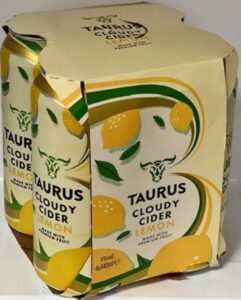Retail Scanner
[Un]Fair Play – A look at the Thatchers and Lidl judgements
March 2024
We look at unfair advantage and detriment through the lens of the recent Lidl v Tesco and Thatchers v Aldi judgments. Two very different outcomes on the same legal principles and perhaps a point of contention on appeal.
The disputes
In Thatchers v Aldi, the dispute revolves around the overall appearance of the THATCHERS CLOUDY LEMON CIDER – for which Thatchers has a trade mark registration for the device mark seen below – and Aldi’s TAURUS CLOUDY LEMON CIDER product (also seen below).
Thatchers claimed that Aldi intentionally set out to link its own brand cider with Thatchers’ product, taking unfair advantage of the reputation of the Thatchers trade mark. Thatchers also brought an additional claim of passing off.
The Court concluded that Thatchers’ trade mark had reputation in the UK and Aldi’s product would call to mind the trade mark but there was no unfair advantage of or detriment to the reputation of the trade mark. The passing off claim also failed as there was also no misrepresentation on Aldi’s part. We are not aware of an appeal to date.
Lidl v Tesco ‘circles around’ Lidl’s logo and wordless mark and the yellow circle device on a blue background, used by Tesco for its “Clubcard Prices” loyalty discount scheme, seen above.
Lidl accused Tesco of infringing its LIDL logo and wordless mark by deliberately seeking to free-ride on the reputation of Lidl as a ‘discounter’ supermarket known for the provision of value. Additional claims of passing off and copyright infringement were also brought by Lidl.
The Court held that Tesco gained an unfair advantage by associating its prices with Lidl and its reputation for low price value. There was also passing off and copyright infringement. The decision is under appeal and the three-day hearing concluded on 23rd February.
The law – Detriment & Unfair advantage
Detriment subsists when a mark’s ability to identify the goods or services (for which it is registered and used) as coming from the owner of that mark is weakened. This may be because the use of the later mark makes difficult for the public to rely on its image of the earlier mark to identify the commercial origin of the goods or services or because the use of the later mark negatively influences the image of the earlier mark.
It not critical that the owner of the later mark draws a real commercial benefit from its association with the earlier mark but although the risk of detriment may be established by deduction, this needs to be more than supposition. For example, the need of a proprietor having to take ‘evasive action’ to re-establish or amplify the distinctiveness of its mark as to avoid being crowded out by the use of the later mark can denote a serious risk of detriment.
Unfair advantage refers to the legal concept of the advantage taken by the party as a result of the use of an identical or similar later mark to a mark with reputation. It covers in particular cases where by reason of ‘transferring’ and free-riding on the image of the mark with reputation to the later mark, the later mark gains an advantage of sorts.
Determining whether there is unfair advantage calls for a global assessment of all factors relevant in the circumstances of the case, including the strength of the earlier mark’s reputation, the distinctiveness of the earlier mark, the degree of similarity between the marks and goods or services.
The law is not prescriptive as to what may be an ‘unfair’ ‘advantage’ but an economic advantage alone is not enough. Nor is it necessary for a party to intentionally exploit the reputation of the earlier mark.
A finding of detriment and/or unfair advantage calls for a change in economic behaviour of customers for the defendants’ goods or services to be shown. But actual evidence of a change in the economic behaviour of consumers is often difficult to obtain so likelihood of such a change could suffice.
The Judgements – Detriment & Unfair advantage
Justice Smith on Lidl v Tesco considered that there was detriment & unfair advantage not least because:
- Lidl had to take ‘corrective’ action by putting out adverts to demonstrate the higher prices of Tesco Clubcard products compared to those of Lidl
- the objective effect of the creation of the link between the marks meant that Tesco took unfair advantage of the distinctive reputation in Lidl’s marks for low price (discounted) value;
- Tesco’s mark intended to convey value which was easier and more effective by reason of the connection with the Lidl marks whose reputation was low price value.
There was detriment and unfair advantage despite Lidl accepting that it could not point to any specific individual who has acknowledged a change in economic behaviour and in spite Tesco’s argument that there was no unfair advantage because if one bought all the products covered by Clubcard Prices guarantee it would result in an exactly similar, or lower, spend by comparison with an equivalent shop at Lidl.
Justice Clarke on Thatchers v Aldi considered there was no detriment & unfair advantage despite:
- having found that Thatchers trade mark is similar to Aldi’s mark;
- the Thatchers trade mark has a reputation – it was agreed that the design of the Thatchers packaging added to the attractiveness of the Thatchers product and the presence of whole lemons was attracting custom;
- having found a link between the marks – Thatchers adduced evidence of members of the public comparing the taste of the two products and comments about the Aldi Product being a “rip off” or “knock off” of the Thatchers Product.
But ultimately tis was not enough to find a change in the economic behaviour of the consumer.
Conclusions
It would not be surprising for Thatchers to feel somewhat hard done by the decision.
While the THATCHERS TAURUS product names were clearly dissimilar, the overall products – with the whole lemons and same colour scheme – were similar enough to be linked in the mind of public. In the Lidl case, there was evidence that the colour blue has long been associated with Tesco, while yellow has been recognised as having “the best impact” for point of sale material. So, in both cases, the marks involved had ‘weaknesses’ which nevertheless did not detract from a finding of similarity and link.
On the point of change in the economic behaviour of the consumer, Lidl got over the line on the basis that Tesco’s ‘Clubcard Prices’ mark intended “to convey value and thereby to influence the economic behaviour of supermarket shoppers” notwithstanding that there was no specific intention to free ride on Lidl’s reputation. In Thatchers, the possibility of someone buying the Aldi product instead of the Thatchers product, driven by the link and price differential between the two products, was not deemed enough of a risk to the economic behaviour of the consumer.
Justice Clarke’s findings on Thatchers may have been influenced by:
- the Aldi Product no longer being on the market;
- the need of an advantage to be more than just an economic advantage;
- the improbability of the Aldi Product casting the Thatchers Product in a negative light.
It is a finely balanced decision, but my sense is that on another day the decision could have gone Thatchers’ way and it was perhaps held to a stricter standard than Lidl; Aldi will take the win for now –
“not quite Thatchers Lemon but for half the price there’s not much to complain about”.
Links to the judgements found below.



































